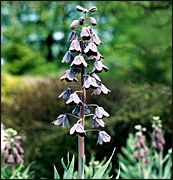Whether you accept it, avoid it or live somewhere in between, insurance coverage has become a defining issue for our profession. Patients increasingly expect to use their benefits, practitioners want to be compensated fairly for their time and expertise, and the system itself remains – at best – fragmented. The encouraging news is that coverage has expanded in meaningful ways. The challenging news is that reimbursement, across the board, remains inadequate.
Herbs & Botanicals
Fritillaria (chuan bei mu)
What is fritillaria? What is it used for?
Fritillaria is a perennial, flowering plant that is part of the lily family. It grows in the meadows and mountain slopes of Nepal and China. Several species of fritillaria are used medicinally; the plant's bulb is processed and used in various herbal formulas.
As a medicine, fritillaria is graded into four categories (song pei, lu pei, ching pei or ming pei) depending on the plant’s shape and the region in which it was grown.
In traditional Chinese medicine, fritillaria has bitter, sweet, and slightly cold properties. The bulb's color, white, is believed to affect the heart and lung meridians. As such, it is used to treat various lung conditions, such as asthma, bronchitis and tuberculosis.
 Fritillaria is particularly useful for all types of coughs. TCM practitioners often employ fritillaria to moisten dry mucus membranes, resolve phlegm and control coughing. Research conducted in China has shown that compounds in fritillaria (including verticine, verticinone, imperialine and thymidine) help inhibit the contraction of bronchial smooth muscle and decrease mucus secretion.
Fritillaria is particularly useful for all types of coughs. TCM practitioners often employ fritillaria to moisten dry mucus membranes, resolve phlegm and control coughing. Research conducted in China has shown that compounds in fritillaria (including verticine, verticinone, imperialine and thymidine) help inhibit the contraction of bronchial smooth muscle and decrease mucus secretion.
Fritillaria is also used as a decongestant, and to reduce swelling.
How much fritillaria should I take?
The standard dose of fritillaria ranges from 1-1.5 grams daily (taken as a powder) to 3-12 grams (as part of a decoction or tea). The herb also may be applied externally as a cream.
What forms of fritillaria are available?
Fritillaria is quite hard to find in American health food stores, but processed forms are available at some herb shops and Asian markets. Because raw fritillaria bulb is toxic, all medicinal forms are processed, usually as a powder or capsule. Whole bulbs that have been boiled or steamed, then dried, may also be available.
What can happen if I take too much fritillaria? Are there any interactions I should be aware of? What precautions should I take?
Raw or unprocessed fritallaria bulb is toxic and should not be consumed. Pregnant women and those with weak digestive systems are also advised to not take fritallaria unless under the advice of a practitioner trained in its use.
As of this writing, there are no known drug interactions with fritallaria. Traditionally, however, it is not combined with aconite root or gentiana. As always, make sure to speak with a licensed health care provider before taking fritallaria or any herbal remedy or dietary supplement.
References
- Bensky D, Gamble A. Chinese Herbal Medicine: Materia Medica, revised edition. Seattle: Eastland Press, 1993.
- Fan W. A Manual of Chinese Herbal Medicine: Principles and Practice for Easy Reference. East Lansing, MI: Shambala, 1996.
- Fritillaria. Gale Encyclopedia of Alternative Medicine. Gale Group, 2001.
- Holmes P. Jade Remedies: A Chinese Herbal Reference for the West. Boulder, CO: Snow Lotus Press, 1997.


